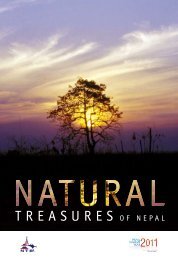treasures of nepal
treasures of nepal
treasures of nepal
- No tags were found...
You also want an ePaper? Increase the reach of your titles
YUMPU automatically turns print PDFs into web optimized ePapers that Google loves.
Swayambhu Maha ChaityaKathmandu Valley has also some very importantand highly venerated Buddhist sites. As oneenters the valley, the first sight to catch thevisitor’s eye is the hemispherical white dome(stupa) <strong>of</strong> the Swayambhu Maha Chaitya perchedmajestically atop a hill on the western fringe<strong>of</strong> the Kathmandu Valley. The stupa symbolisesthe body <strong>of</strong> the Buddha, which is nothing otherthan the cosmos itself. The Swayambhu MahaChaitya with the semi-closed eyes <strong>of</strong> the Buddhaoverlooking the valley from all four directionsis the most prominent monument and landmark<strong>of</strong> the valley. The historical origins <strong>of</strong> this greatstupa are obscure, but it is believed to havebeen built during the Lichchhavi period. Themain stupa is a huge white dome in the form<strong>of</strong> a flattened hemisphere. Around the circularbase - the garva (womb) - are installed the fivecelestial Buddhas with their respective femalecounterparts. In the vicinity are numerousmonuments. These include the twin Shikharastyletemples <strong>of</strong> Pratappur and Anantapur builtby King Pratap Malla; Basupur, with the image <strong>of</strong>Goddess Basundhara, the bestower <strong>of</strong> prosperity;Vayupur, the god <strong>of</strong> wind; and the artistic goldentemple <strong>of</strong> the Goddess Ajima or Harati, theprotector <strong>of</strong> children.The Swayambhu Maha Chaitya is a veritabletreasure house <strong>of</strong> valuable artefacts <strong>of</strong> bronzeand stone images and miniature chaityas. On thewestern side <strong>of</strong> the stupa in front <strong>of</strong> the Haratitemple, there is a stone pillar on top <strong>of</strong> whichare some very striking bronze statues. On theeastern side, atop a Mandala, there is a massiveVajra, or thunderbolt. This golden Vajra, knownas dorje in Tibetan, is the symbol <strong>of</strong> VajrayanaBuddhism. In the vicinity <strong>of</strong> the great stupathere are Tibetan, Bhutanese and Nepalesevihars and gumbas, as well as a museum wherenumerous religious manuscripts and bronzeand stone images <strong>of</strong> both Buddhist and Hindudeities are on display. Indeed, the entire site is aunique open-air museum, unparalleled elsewherein the world.Boudhanath StupaThe great Stupa <strong>of</strong> Boudhanath is the principalcentre <strong>of</strong> Tibetan Buddhist worship in theKathmandu Valley. It has long been a majordestination for pilgrims from the Himalayas,Tibet and southeast and east Asia. It is one<strong>of</strong> the largest and most magnificent Buddhistmonuments in the world. Lichchhavi KingManadeva I (reign 464-505 A.D.) is credited tohave built this great stupa.LumbiniThere cannot be a more revered pilgrimagesite for Buddhists than Lumbini, the birthplace <strong>of</strong> Shakya Muni Buddha. Buddha, theprince <strong>of</strong> peace and non-violence, was bornat Lumbini in 623 B.C. For centuries, pilgrimstravelling from afar revered the spot at theLumbini garden where Gautama Buddha wasborn, building stupas, monasteries and othertypes <strong>of</strong> monuments. The most notable andimportant is the stone pillar erected by EmperorAshoka Maurya in the 3rd century B.C., whichauthenticates the exact spot where Queen MayaDevi gave birth to the blessed one. Today, thesite is being developed as a major internationalpilgrimage destination with the assistance <strong>of</strong>20




